Optical Study on the Effects of Methane Equivalence Ratio and Diesel Injection Mass on Diesel-Ignited Methane Combustion Process
Abstract
:1. Introduction
2. Experimental Setup and Methods
2.1. Test Bench
2.2. Experimental Conditions
2.3. Processing Methods
3. Results, Discussion, and Analysis
3.1. The Influence of Methane Premixed Mixture Equivalence Ratio
3.1.1. The Development Pattern of Flames
3.1.2. The Generation Characteristics of OH
3.1.3. Combustion Characteristics
3.2. The Influence of Pilot Diesel Injection Mass
3.2.1. The Development Pattern of Flames
3.2.2. The Generation Characteristics of OH
3.2.3. Combustion Characteristics
4. Conclusions
- (1)
- During the early diesel dominance combustion stage, increasing the methane equivalence ratio inhibits the combustion of diesel, resulting in a longer ignition delay period and a decline in flame propagation. However, in the premixed combustion stage of methane, flame propagation is enhanced by increasing the methane equivalence ratio.
- (2)
- The evolution of OH during the dual-fuel combustion process presents characteristic segmented growth. A lower methane equivalence ratio leads to an earlier generation of OH radicals but a lower average intensity in the premixed combustion stage.
- (3)
- With the increase in the methane equivalence ratio, the pmax and HRRmax are both promoted, especially the HRRmax. Although the CA10 is delayed, the overall combustion duration is shortened by the increase in the methane equivalence ratio.
- (4)
- Increasing the diesel injection mass results in a larger flame area and greater OH generation intensity in the ignition region. However, a prolonged injection duration may impede the propagation of the methane flame along the direction to the diesel nozzle.
- (5)
- The pmax and HRRmax increase when the injection mass of pilot diesel increases from 4% to 6%, and then to 8%. However, when it increases from 8% to 10%, the pmax and HRRmax both decrease, and the combustion duration is also prolonged. An appropriate increase in the mass of pilot diesel fuel can promote the overall combustion performance, but too much may be counterproductive.
Author Contributions
Funding
Data Availability Statement
Conflicts of Interest
Abbreviations
| RCEM | Rapid compression and expansion machine |
| TDC | Top dead center |
| BDC | Bottom dead center |
| FPS | Frames per second |
| BP | Band pass |
| pC | Picometer Coulomb |
| NL | Natural luminescence |
| CL | Chemiluminescence |
| Φ | Pre-mixed gas fuel–air equivalence ratio |
| A | Energy ratio of diesel to methane |
| Ɵ | Orifice axis angle |
| ASOI | After start of injection |
| V | Cylinder volume |
| γ | Adiabatic coefficient |
| p | Cylinder pressure |
| φ | Crank Angle |
| HRR | Heat release rate |
| CA10/50/90 | The crankshaft angle when the cumulative released heat reaches 10%/50%/90% of the maximum heat release |
| OH | Hydroxyl radical |
References
- Zarrinkolah, M.T.; Hosseini, V. Methane slip reduction of conventional dual-fuel natural gas diesel engine using direct fuel injection management and alternative combustion modes. Fuel 2023, 331, 125775. [Google Scholar] [CrossRef]
- Kumar, S.; Goga, G. Emission characteristics & performance analysis of a diesel engine fuelled with various alternative fuels—A review. Mater. Today Proc. 2023. [Google Scholar] [CrossRef]
- Zhang, Q.; Wang, X.; Song, G.; Li, M. Performance and emissions of a pilot ignited direct injection natural gas engine operating at slightly premixed combustion mode. Fuel Process. Technol. 2022, 227, 107128. [Google Scholar] [CrossRef]
- Li, M.; Wu, H.; Liu, X.; Wei, Z.; Li, Z. Numerical investigations on pilot ignited high pressure direct injection natural gas engines: A review. Renew. Sustain. Energy Rev. 2021, 150, 111390. [Google Scholar] [CrossRef]
- Fang, Z.; Dong, X.; Tang, X.; Lv, Z.; Qiao, X.; Wang, L.; Yu, X. Study on supercritical CO2 power cycles for natural gas engine energy cascade utilization. Appl. Therm. Eng. 2023, 225, 120255. [Google Scholar] [CrossRef]
- Li, M.; Li, C.; Wei, Z.; Zhang, Q.; Rao, Z. Numerical study on the combustion and emission characteristics of a direct injection natural gas engine ignited by diesel/n-butanol blends. Appl. Therm. Eng. 2023, 226, 120333. [Google Scholar] [CrossRef]
- Luo, K.; Huang, Y.; Li, Y.; Tao, Y.; Hu, Z. Effects of high pressure and high-low pressure EGR strategies on the knock tendency, combustion, and performance of a stoichiometric operation natural gas engine. Fuel 2023, 348, 128530. [Google Scholar] [CrossRef]
- Lu, Z.; Ma, M.; Wang, T.; Lu, T.; Wang, H.; Feng, Y.; Shi, L. Numerical research of the in-cylinder natural gas stratification in a natural gas-diesel dual-fuel marine engine. Fuel 2023, 337, 126861. [Google Scholar] [CrossRef]
- Sun, X.; Liu, H.; Duan, X.; Guo, H.; Li, Y.; Qiao, J.; Liu, J. Effect of hydrogen enrichment on the flame propagation, emissions formation and energy balance of the natural gas spark ignition engine. Fuel 2022, 307, 121843. [Google Scholar] [CrossRef]
- Binyang, W.; Puze, Y.; Yinmi, L.; Zhi, J. Effects and mechanism of pilot diesel injection strategies on combustion and emissions of natural gas engine. Proc. Inst. Mech. Eng. Part D J. Automob. Eng. 2023, 2023, 09544070221145738. [Google Scholar] [CrossRef]
- Chen, X.; Zeng, W.; Zheng, W.; Hu, E.; Ma, H. Experimental and kinetic modeling study on the oxidation and laminar combustion characteristics of natural gas. Fuel 2023, 344, 128019. [Google Scholar] [CrossRef]
- Hall, C.; Kassa, M. Advances in combustion control for natural gas–diesel dual fuel compression ignition engines in automotive applications: A review. Renew. Sustain. Energy Rev. 2021, 148, 111291. [Google Scholar] [CrossRef]
- Li, Y.; Yang, F.; Linxun, X.; Liu, J.; Wang, J.; Duan, X. Influences of the control parameters and spark plug configurations on the performance of a natural gas spark-ignition engine. Fuel 2022, 324, 124728. [Google Scholar] [CrossRef]
- Pan, K.; Wallace, J.S. A low temperature natural gas reaction mechanism for compression ignition engine application. Combust. Flame 2019, 202, 334–346. [Google Scholar] [CrossRef]
- Gharehghani, A.; Salahi, M.M.; Andwari, A.M.; Mikulski, M.; Könnö, J. Reactivity enhancement of natural gas/diesel RCCI engine by adding ozone species. Energy 2023, 274, 127341. [Google Scholar] [CrossRef]
- Wang, Z.; Fu, X.; Wang, D.; Xu, Y.; Du, G.; You, J. A multilevel study on the influence of natural gas substitution rate on combustion mode and cyclic variation in a diesel/natural gas dual fuel engine. Fuel 2021, 294, 120499. [Google Scholar] [CrossRef]
- Chen, W.; Pan, J.; Liu, Y.; Fan, B.; Liu, H.; Otchere, P. Numerical investigation of direct injection stratified charge combustion in a natural gas-diesel rotary engine. Appl. Energy 2019, 233, 453–467. [Google Scholar] [CrossRef]
- Wang, Z.; Zhang, F.; Xia, Y.; Wang, D.; Xu, Y.; Du, G. Combustion phase of a diesel/natural gas dual fuel engine under various pilot diesel injection timings. Fuel 2021, 289, 119869. [Google Scholar] [CrossRef]
- Cong, Y.; Gan, H.; Wang, H. Parameter investigation of the pilot fuel post-injection strategy on performance and emissions characteristics of a large marine two-stroke natural gas-diesel dual-fuel engine. Fuel 2022, 323, 124404. [Google Scholar] [CrossRef]
- Felayati, F.M.; Cahyono, B.; Bakar, R.A.; Birouk, M. Performance and emissions of natural gas/diesel dual-fuel engine at low load conditions: Effect of natural gas split injection strategy. Fuel 2021, 300, 121012. [Google Scholar] [CrossRef]
- Altinkurt, M.D.; Merts, M.; Tunér, M.; Turkcan, A. Effects of split diesel injection strategies on combustion, knocking, cyclic variations and emissions of a natural gas-diesel dual fuel medium speed engine. Fuel 2023, 347, 128517. [Google Scholar] [CrossRef]
- Park, H.; Shim, E.; Lee, J.; Oh, S.; Kim, C.; Lee, Y.; Kang, K. Comparative evaluation of conventional dual fuel, early pilot, and reactivity-controlled compression ignition modes in a natural gas-diesel dual-fuel engine. Energy 2023, 268, 126769. [Google Scholar] [CrossRef]
- Liu, J.; Liu, Y.; Ji, Q.; Sun, P.; Zhang, X.; Wang, X.; Ma, H. Effects of split injection strategy on combustion stability and GHG emissions characteristics of natural gas/diesel RCCI engine under high load. Energy 2023, 266, 126542. [Google Scholar] [CrossRef]
- Liu, J.; Zhang, X.; Liu, Y.; Sun, P.; Ji, Q.; Wang, X.; Ma, H. Experimental study on in-cylinder combustion and exhaust emissions characteristics of natural gas/diesel dual-fuel engine with single injection and split injection strategies. Process Saf. Environ. Prot. 2023, 172, 225–240. [Google Scholar] [CrossRef]
- Liu, J.; Guo, Q.; Guo, J.; Wang, F. Optimization of a diesel/natural gas dual fuel engine under different diesel substitution ratios. Fuel 2021, 305, 121522. [Google Scholar] [CrossRef]
- Yang, K.; Wang, Z.; Zhang, K.; Wang, D.; Xie, F.; Xu, Y.; Yang, K. Impact of natural gas injection timing on the combustion and emissions performance of a dual-direct-injection diesel/natural gas engine. Energy 2023, 270, 126813. [Google Scholar] [CrossRef]
- Yang, X.; Dong, Q.; Wang, X.; Zhou, T.; Wei, D. An experimental study on the needle valve motion characteristics of high pressure natural gas and diesel co-direct injector. Energy 2023, 265, 126257. [Google Scholar] [CrossRef]
- Oh, S.; Oh, J.; Jang, H.J.; Lee, S.; Lee, S.; Kim, C.; Lee, J. Effects of piston shape and nozzle specifications on part-load operation of natural gas–diesel dual-fuel RCCI engine and its application to high load extension. Fuel 2022, 328, 125361. [Google Scholar] [CrossRef]
- Jagadish, D.; NageswaraRao, A.V.; Kumar, M.S. Engine combustion and emission analysis using optical methods: An overview. Mater. Today Proc. 2023. [Google Scholar] [CrossRef]
- Tian, J.; Cui, Z.; Ren, Z.; Tian, H.; Long, W. Experimental study on jet ignition and combustion processes of natural gas. Fuel 2020, 262, 116467. [Google Scholar] [CrossRef]
- Zhang, X.; Tian, J.; Cui, Z.; Xiong, S.; Yin, S.; Wang, Q.; Long, W. Visualization study on the effects of pre-chamber jet ignition and methane addition on the combustion characteristics of ammonia/air mixtures. Fuel 2023, 338, 127204. [Google Scholar] [CrossRef]
- Kim, W.; Park, C.; Bae, C. Characterization of combustion process and emissions in a natural gas/diesel dual-fuel compression-ignition engine. Fuel 2021, 291, 120043. [Google Scholar] [CrossRef]
- Kim, W.; Park, C.; Bae, C. Combustion Phenomena and Emissions in a Dual-Fuel Optical Engine Fueled with Diesel and Natural Gas. SAE Int. J. Adv. Curr. Pract. Mobil. 2021, 4, 502–513. [Google Scholar] [CrossRef]
- Ahmad, Z.; Kaario, O.; Qiang, C.; Vuorinen, V.; Larmi, M. A parametric investigation of diesel/methane dual-fuel combustion progression/stages in a heavy-duty optical engine. Appl. Energy 2019, 251, 113191. [Google Scholar] [CrossRef]
- Zhu, Z.; Li, Y.; Shi, C. Effect of natural gas energy fractions on combustion performance and emission characteristics in an optical CI engine fueled with natural gas/diesel dual-fuel. Fuel 2022, 307, 121842. [Google Scholar] [CrossRef]
- Dahl, K.R.; Ghandhi, J.; Rothamer, D. Optical Investigation of the Impact of Pilot Ratio Variations on Natural Gas Diesel Dual-Fuel Combustion. SAE Tech. Pap. 2019, 2019-01-1159. [Google Scholar] [CrossRef]
- Di Iorio, S.; Magno, A.; Mancaruso, E.; Vaglieco, B.M. Analysis of the effects of diesel/methane dual fuel combustion on nitrogen oxides and particle formation through optical investigation in a real engine. Fuel Process. Technol. 2017, 159, 200–210. [Google Scholar] [CrossRef]
- Mancaruso, E.; Todino, M.; Vaglieco, B.M. Study on dual fuel combustion in an optical research engine by infrared diagnostics varying methane quantity and engine speed. Appl. Therm. Eng. 2020, 178, 115623. [Google Scholar] [CrossRef]
- Hultqvist, A.; Christensen, M.; Johansson, B.; Franke, A.; Richter, M.; Aldén, M. A study of the homogeneous charge compression ignition combustion process by chemiluminescence imaging. SAE Trans. 1999, 108, 2114–2127. [Google Scholar] [CrossRef]
- Kawahara, N.; Tomita, E.; Kagajyo, H. Homogeneous charge compression ignition combustion with dimethyl ether-Spectrum analysis of chemiluminescence. SAE Trans. 2003, 112, 1214–1221. [Google Scholar] [CrossRef]
- Mehra, R.K.; Duan, H.; Juknelevičius, R.; Ma, F.; Li, J. Progress in hydrogen enriched compressed natural gas (HCNG) internal combustion engines—A comprehensive review. Renew. Sustain. Energy Rev. 2017, 80, 1458–1498. [Google Scholar] [CrossRef]
- Wang, B.; Yao, A.; Yao, C.; Chen, C.; Wang, H. In-depth comparison between pure diesel and diesel methanol dual fuel combustion mode. Appl. Energy 2020, 278, 115664. [Google Scholar] [CrossRef]
- Brunt, M.F.; Rai, H.; Emtage, A.L. The calculation of heat release energy from engine cylinder pressure data. SAE Trans. 1998, 107, 1596–1609. [Google Scholar] [CrossRef]
- Srna, A.; Bolla, M.; Wright, Y.M.; Herrmann, K.; Bombach, R.; Pandurangi, S.S.; Boulouchos, K.; Bruneaux, G. Effect of methane on pilot-fuel auto-ignition in dual-fuel engines. Proc. Combust. Inst. 2019, 37, 4741–4749. [Google Scholar] [CrossRef]
- Schlatter, S.; Schneider, B.; Wright, Y.M.; Boulouchos, K. N-heptane micro pilot assisted methane combustion in a Rapid Compression Expansion Machine. Fuel 2016, 179, 339–352. [Google Scholar] [CrossRef]
- Sun, L.; Liu, Y.; Zeng, K.; Yang, R.; Hang, Z. Combustion performance and stability of a dual-fuel diesel–natural-gas engine. Proc. Inst. Mech. Eng. Part D J. Automob. Eng. 2015, 229, 235–246. [Google Scholar] [CrossRef]


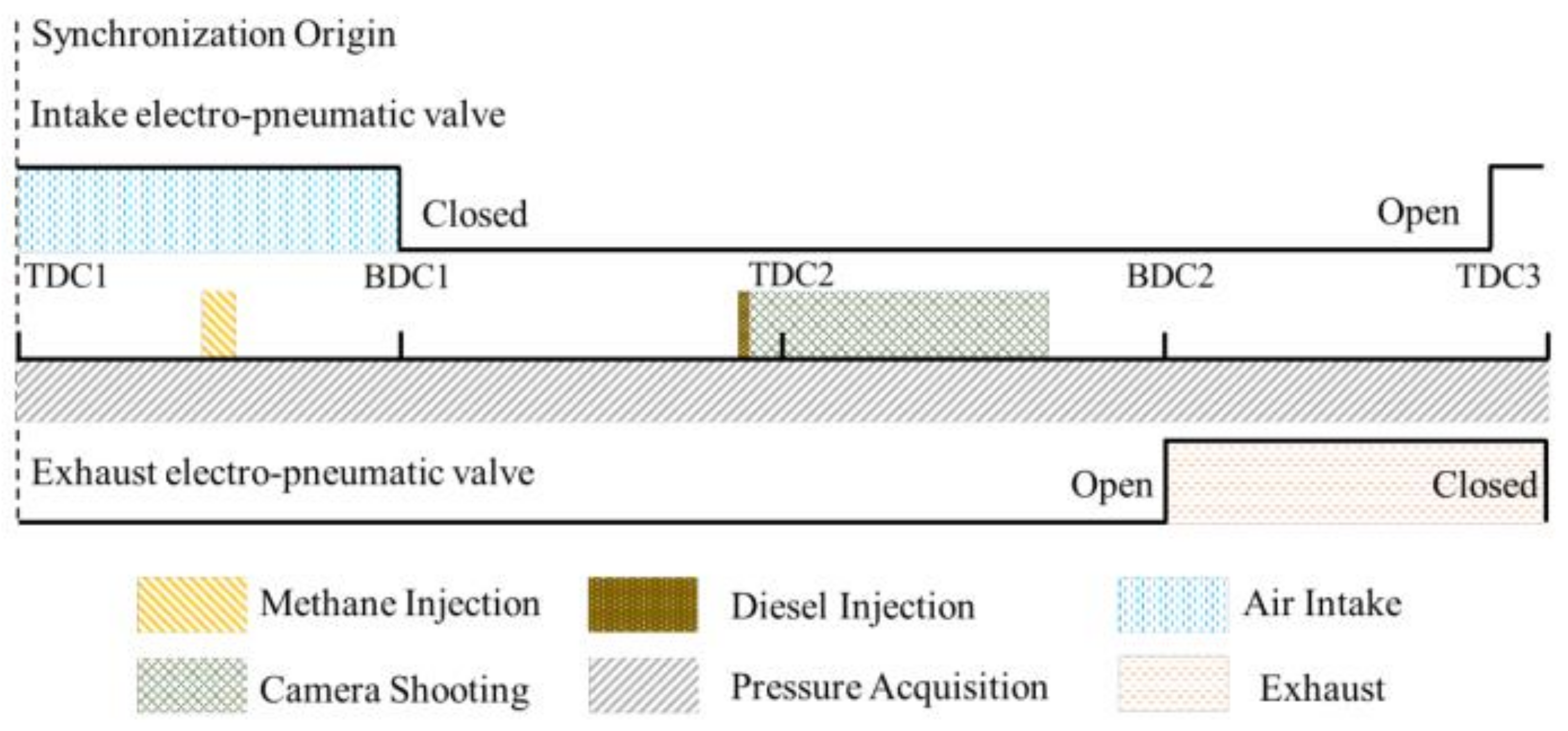





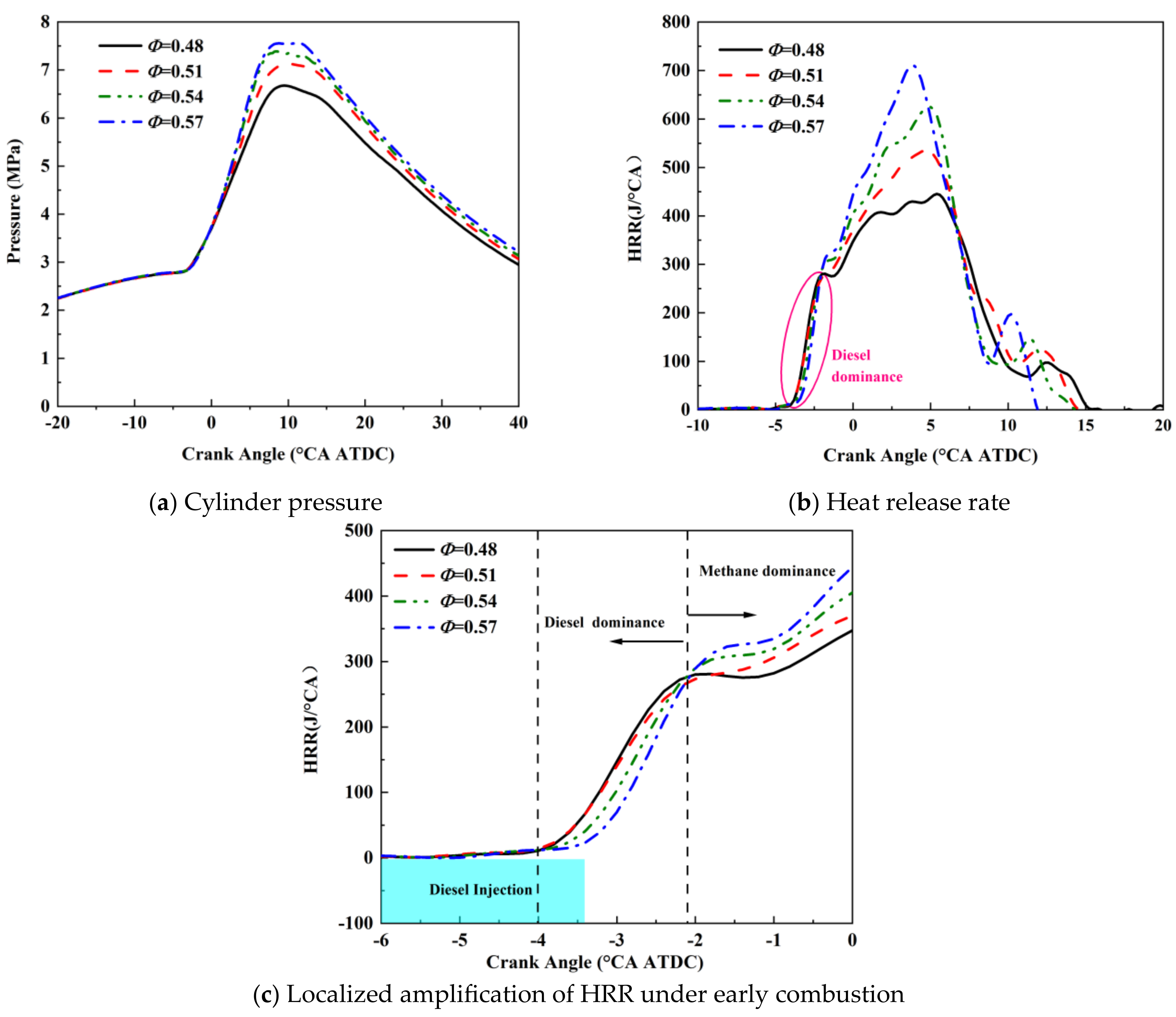
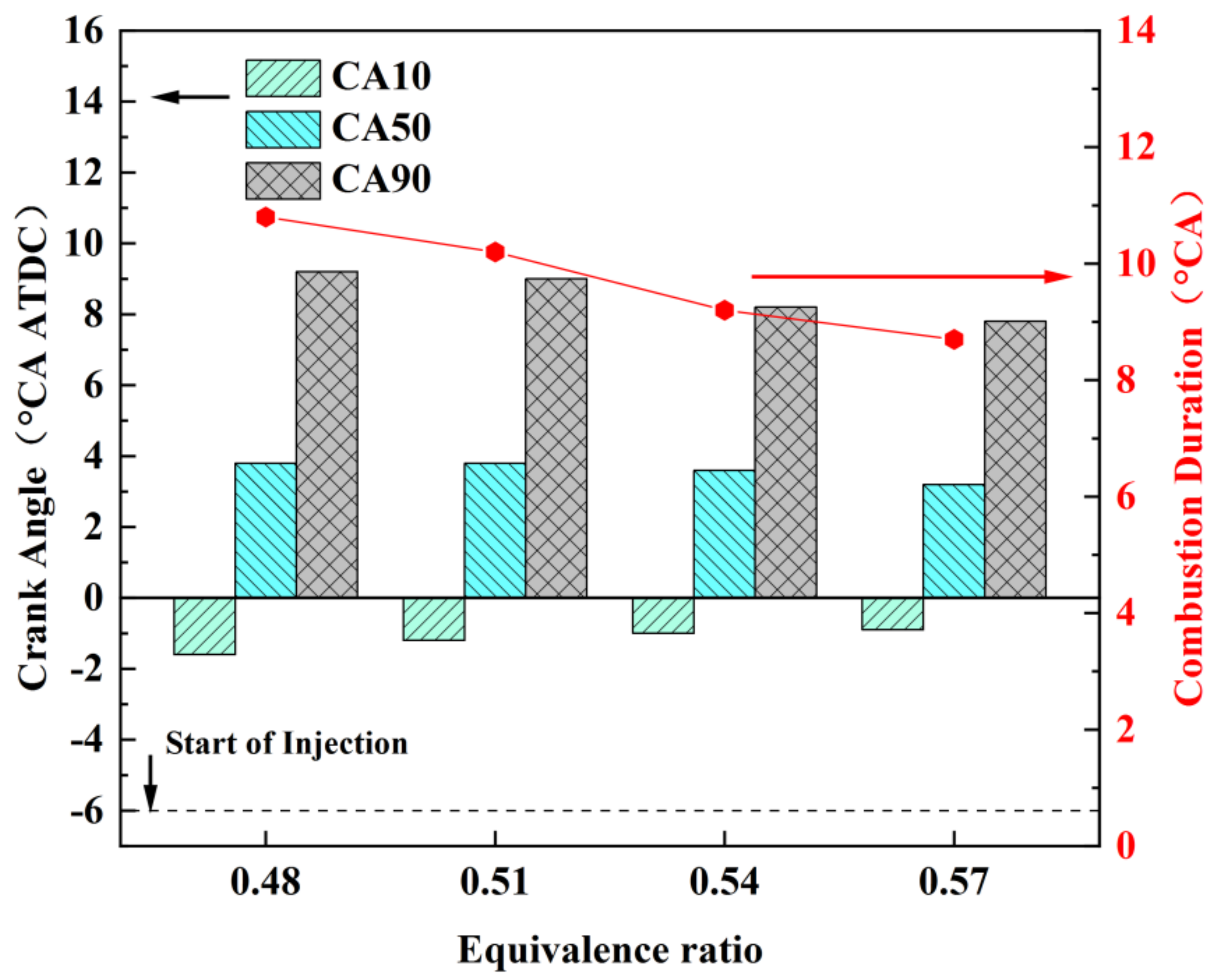
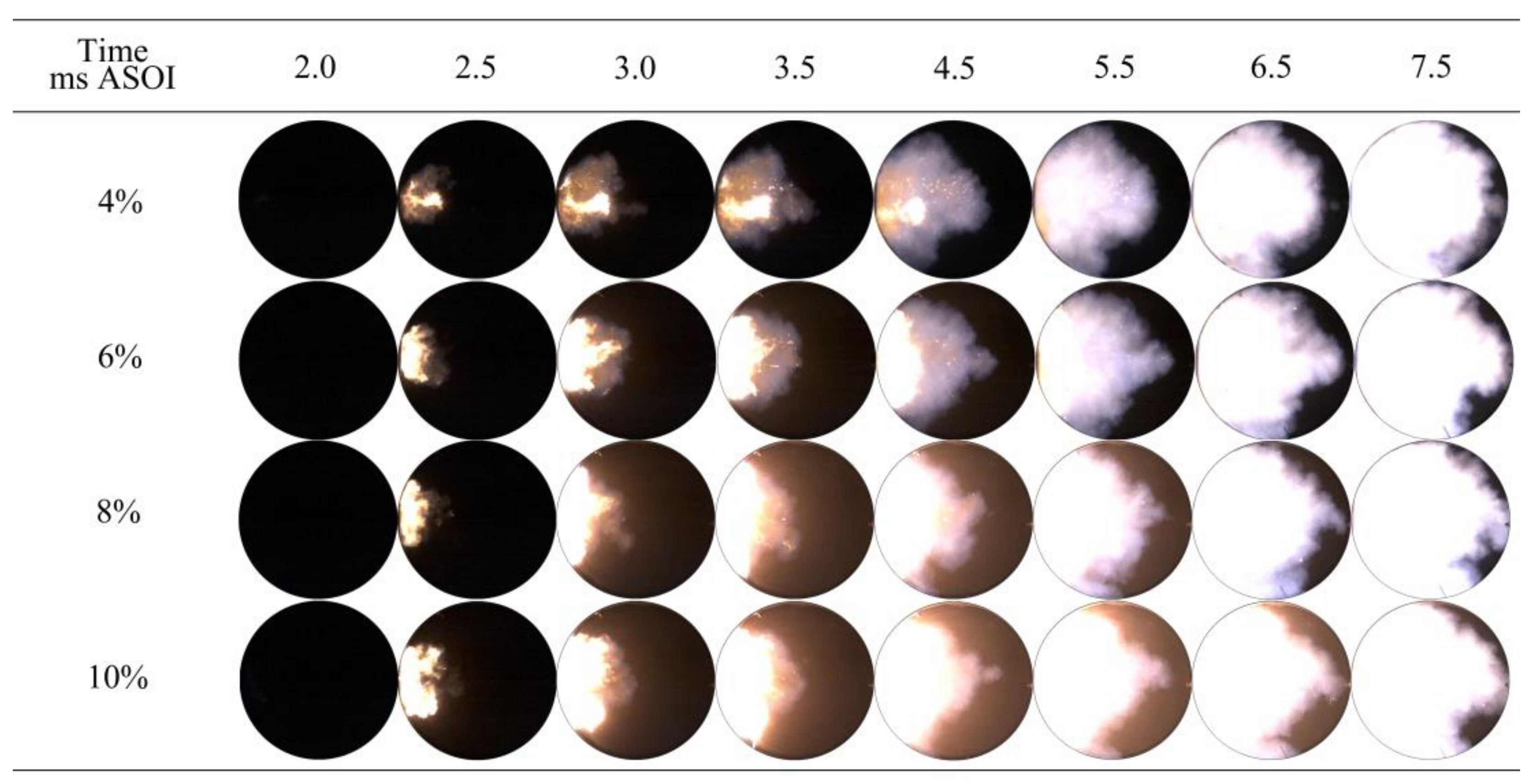

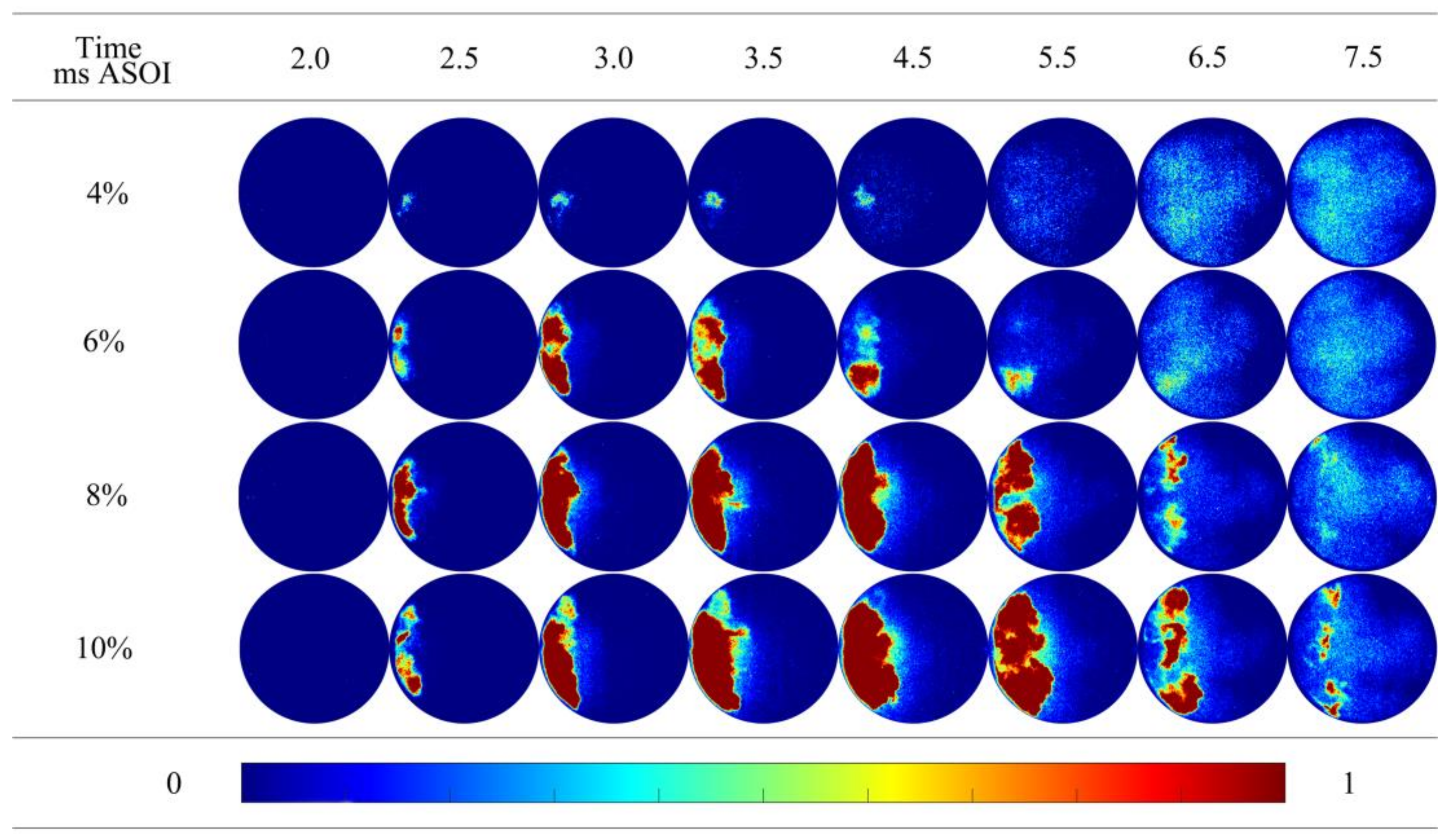

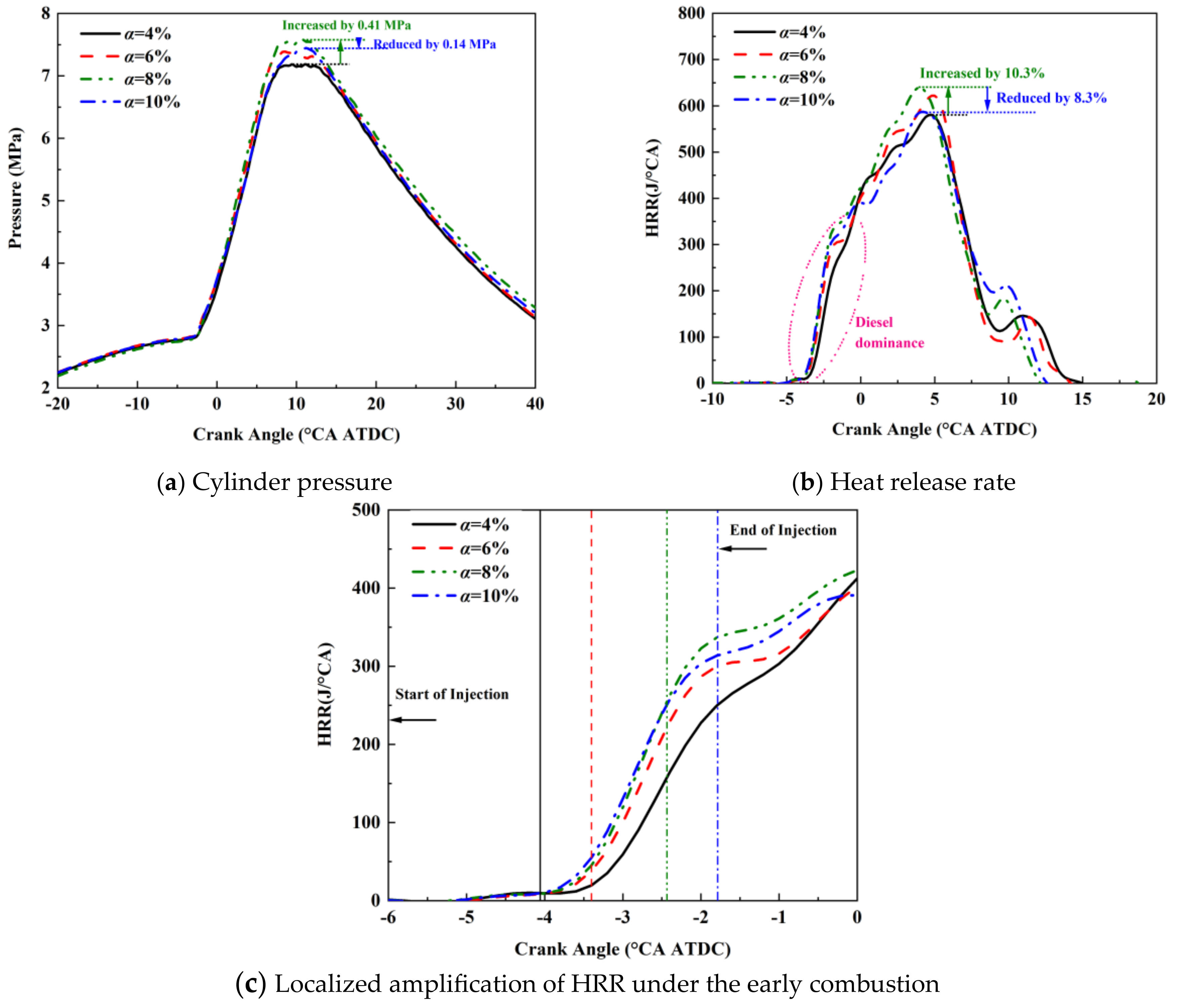

| Shooting Device | Technical Specification | Application | |
|---|---|---|---|
| High-speed color camera | Photron mini UX 100 Frame rate: 10,000 FPS | NL photography | |
| High-speed gray camera | Photron SA-Z Frame rate: 20,000 FPS | CL photography | |
| High-speed image intensifier | UVi 2550 Gate interval: 0.0001 ms | Image intensifying | |
| Filter | BP 313 ± 12.5 nm | OH filtering | |
| Measuring Device | Technical specification | Application | Uncertainty |
| Pressure sensor | Kistler 6052C Sensitivity: −17.68 pC/barSample frequency: 5 points/°CA | Pressure acquisition | ±1% |
| Charge amplifier | Kistler 5018A Measuring range: ±2 to 2,200,000 pC | Charge–voltage signal conversion and amplification | ±0.3% |
| Temperature sensor | WRNK-191 K-type Measuring range: 0 to 1100 °C | Temperature measurement and monitoring | ±0.75% |
| Parameters | Value |
|---|---|
| Temperature before compression (T0/K) | 480 ± 3 |
| Air intake pressure (pin/bar) | 3.6 |
| Temperature at TDC2 (Ttdc/K) | 823 |
| Pressure at TDC2 (ptdc/MPa) | 2.7 |
| Methane injection mass (mM/mg) | 112/120/128/136 |
| Diesel injection mass (mD/mg) | 6.04/9.06/12.07/15.09 |
| Diesel injection duration (Dinj/ms) | 1.1/1.5/2.2/2.6 |
| Methane equivalence ratio (Φ) | 0.48/0.51/0.54/0.57 |
| Energy ratio of diesel and methane (α/%) | 4/6/8/10 |
| Diesel injection pressure (pj/MPa) | 80 |
| Diesel injection timing (tinj/°CA ATDC) | −6 |
| Orifice diameter of single orifice nozzle (dn/mm) | 0.15 |
| Properties | Methane | Diesel |
|---|---|---|
| Chemical Formula | CH4 | C16–C23 |
| Stoichiometric Air–Fuel Ratio | 17.2 | 14.3 |
| Octane Number | 130 | 20–30 |
| Cetane Number | <10 | 45–55 |
| Lower Heating Value () | 50 | 42.5 |
| Flame Propagation Speed (c) | 34–37 | - |
| Ignition Limit (%) | 5–15 | 1.5–8.2 |
| Ignition Temperature (°C) | ≈580 | ≈250 |
Disclaimer/Publisher’s Note: The statements, opinions and data contained in all publications are solely those of the individual author(s) and contributor(s) and not of MDPI and/or the editor(s). MDPI and/or the editor(s) disclaim responsibility for any injury to people or property resulting from any ideas, methods, instructions or products referred to in the content. |
© 2023 by the authors. Licensee MDPI, Basel, Switzerland. This article is an open access article distributed under the terms and conditions of the Creative Commons Attribution (CC BY) license (https://creativecommons.org/licenses/by/4.0/).
Share and Cite
Tian, J.; Cui, Z.; Xiao, G.; Wang, Y.; Yin, S.; Shu, D. Optical Study on the Effects of Methane Equivalence Ratio and Diesel Injection Mass on Diesel-Ignited Methane Combustion Process. Processes 2023, 11, 3383. https://doi.org/10.3390/pr11123383
Tian J, Cui Z, Xiao G, Wang Y, Yin S, Shu D. Optical Study on the Effects of Methane Equivalence Ratio and Diesel Injection Mass on Diesel-Ignited Methane Combustion Process. Processes. 2023; 11(12):3383. https://doi.org/10.3390/pr11123383
Chicago/Turabian StyleTian, Jiangping, Zechuan Cui, Ge Xiao, Yang Wang, Shuo Yin, and Deyuan Shu. 2023. "Optical Study on the Effects of Methane Equivalence Ratio and Diesel Injection Mass on Diesel-Ignited Methane Combustion Process" Processes 11, no. 12: 3383. https://doi.org/10.3390/pr11123383





